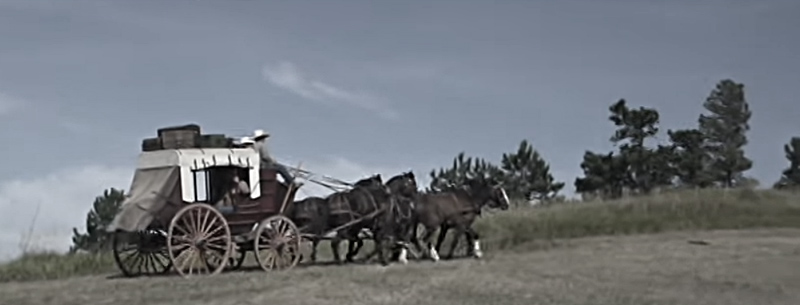From January of 1876 to February of 1887, the Cheyenne-Deadwood Trail was one of the busiest routes in the Wyoming Territory. It was a 200-mile stretch that became a thorofare for travelers, freight, and mail between the two frontier outposts of Cheyenne, Wyoming, and Deadwood, South Dakota. It was the discovery of gold and the establishment of the Black Hills gold fields that brought the need for this north-south route that ran perpendicular to the Oregon and Overland Trails.
The Cheyenne-Deadwood Trail would turn into a rugged highway for stagecoaches protected by armed guards riding shotgun, or on horseback. And the Trail posed its share of danger in the form of horse thieves, or stagecoach robbers, and Sioux warriors protecting their land. More than 600 horses would be used to run the route, at an average of 8 miles an hour. There were stage stops at Fort Laramie and near Lusk and Newcastle at Hat Creek Station and Robber’s Roost. The stages would leave Cheyenne on Mondays and Thursdays and would depart from Deadwood for the return trip to Cheyenne each Tuesday and Saturday.
It was a short-lived run, but in its day, the Cheyenne-Deadwood Trail would serve the West in a big way. Celebrities like Buffalo Bill Cody, Calamity Jane, and Wild Bill Hickock were regulars along the dirt road that was truly a “wild ride”, the Cheyenne-Deadwood Trail.
https://www.youtube.com/watch?v=-pAcgFZ-RN0
Cheyenne-Deadwood Trail Resources
Cheyenne-Deadwood Stage Wyoming Tales and Trails
www.wyomingtalesandtrails.com/deadwood.html
Cheyenne – Deadwood Stage. From Wyoming Tales and Trails. This page: Cheyenne and Blackhills Stage and Express Line, Gilmer and Salisbury.
Cheyenne – Deadwood Trail Historical Marker
www.hmdb.org/m.asp?m=4305
The Cheyenne-Deadwood Trail, a heritage precious to state and nation, was used by gold seekers and Black Hills emigrants from 1876 to 1887. Crossing U. S. Highway 16 at this point, it followed Stockade Beaver Creek passing Beaver Creek Stage Station and winding on to Deadwood via Canyon Springs Stage Station near present Camp Mallo.
Walking 260 miles on the Cheyenne-Deadwood Trail | Opinion …
www.bhpioneer.com/opinion/walking-miles-on-the-cheyenne-deadwood-trail/article_83074542-0549-11e9-b7a9-bf4bd9ff4b9e.html
Walking 260 miles on the Cheyenne-Deadwood Trail By Kaija Swisher, Black Hills Pioneer … on the Cheyenne-Deadwood Trails. … Walker on the Cheyenne-Deadwood Trail,” which tells the story. She …
The Many Trails Into Deadwood Helped Make History
www.blackhillsknowledgenetwork.org/home/the-many-trails-into-deadwood-helped-make-history.html
However, no matter what trail was taken, the Sidney-Deadwood trail would wind up near Custer, Rapid City or Deadwood. The Sidney Trail competed with the Cheyenne Black Hills Stage and Express Line as a gold supplying trail. Like the Cheyenne Stage Line, the Sidney Trail saw its end when railroads to the Black Hills were built in the 1880s.
Cheyenne Deadwood Stagecoach | Newcastle Wyoming
www.newcastlewyo.com/trails/cheyenne-deadwood-stagecoach
If these Hills could talk, they’d surely share the tale of the Cheyenne to Black Hills stagecoach that brought numerous characters through this area from 1876 until the 1887 arrival of the railroad. Thousands of passengers, tons of freight and express, and millions of dollars in gold passed over this trail.
Cheyenne-Deadwood Trail | UW Libraries Digital Repository
uwdigital.uwyo.edu/object/wyu4058
Cheyenne-Deadwood Trail. Title . Cheyenne-Deadwood Trail. Subject . Niobrara County. Wyoming Trails. Cheyenne-Deadwood Trail. Trail. Type . StillImage. Creator(s) Collier, Richard (photographer) Wyoming State Historic Preservation Office. Type of Resource . still image …
Cheyenne Deadwood Stage – ultimate Wyoming
www.ultimatewyoming.com/sectionpages/sec6/extras/cheyennestage.html
Driving north of Lusk you can still see the deep ruts worn on the famous Cheyenne-Deadwood Stage Route. The trail connected the Union Pacific Railroad in Cheyenne with the gold mining region in the Black Hills of Dakota Territory. Often a dangerous and desolate trail for travelers in the 1870s through the 1880s.
